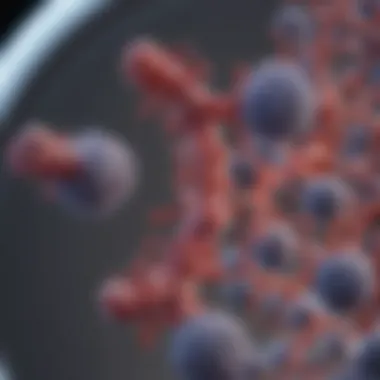The Role and Significance of Galectin-3 Protein in Health and Disease


Intro
Galectin-3 is a fascinating protein that holds significant relevance in both health and disease contexts. As a member of the lectin family, its complex functionality spans various biological processes. Understanding galectin-3 requires exploring its structural attributes, biological roles, and clinical implications, especially in relation to immune responses, cell signaling, and disease mechanisms.
In recent scientific discussions, galectin-3 is increasingly recognized for its potential as a biomarker in conditions such as cardiovascular diseases and cancer. Its dual role as both a participant in pathological processes and a therapeutic target represents a critical focus for many researchers today. This article will delve into these aspects, offering a comprehensive guide to the role of galectin-3 in contemporary health research.
Intro to Galectin-3
Galectin-3 is a protein that attracts attention due to its diverse roles in health and disease. It belongs to the galectin family, which includes various lectins that bind to carbohydrates. Understanding galectin-3 is crucial for uncovering its functionalities in biological processes. This section provides a foundation for exploring the way galectin-3 contributes to numerous physiological and pathological contexts.
Overview of the Galectin Family
The galectin family consists of several proteins, characterized by their ability to bind to beta-galactosides. These proteins play a variety of roles in cellular functions, especially in processes related to the immune system and cell adhesion. Galectins are classified into different types based on their structure and binding specificity.
There are three main classes of galectins:
- Proto-type galectins: These include galectin-1, galectin-2, and galectin-3 and are known for having a single carbohydrate recognition domain.
- Chimeric galectins: These have a single carbohydrate recognition domain fused with other protein domains, enhancing their functionality.
- Tandem-repeat galectins: These are characterized by having two carbohydrate recognition domains.
Galectin-3 stands out within its family, due to its unique structure and multifunctional capabilities. It has an influence on inflammation, cancer progression, and wound healing. Thus, comprehending the galectin family aids in understanding the specific insights and mechanisms involving galectin-3 in health.
Discovery and Historical Context
The identification of galectin-3 began several decades ago. Initially, it was discovered in 1994 by Dr. J. A. Bresalier. The importance of galectin-3 underwent significant scrutiny as researchers began to understand its implications in various biological systems. Early studies focused primarily on its role in immune responses and cellular interactions.
As research advanced, the scope expanded to include pathological roles in diseases such as cancer and heart disease. In the context of cancer, it became clear that galectin-3 could influence tumor progression and metastasis. This historical perspective underlines the evolving understanding of galectin-3, showcasing its multipronged roles in both maintaining health and contributing to disease mechanisms.
Molecular Structure of Galectin-3
The molecular structure of galectin-3 is pivotal to its function and significance in various biological processes. Understanding this structure enables researchers to appreciate how galectin-3 interacts with other biomolecules and its involvement in health and disease. The unique characteristics of galectin-3 allow it to play multifaceted roles, from cell adhesion to immune response modulation. This knowledge can inform therapeutic strategies that target galectin-3 in different diseases.
Protein Domains and Structure
Galectin-3 is a member of the galectin family, distinguished by its specific protein domains and structure. It comprises a carbohydrate recognition domain (CRD) which is essential for its function. The CRD binds to specific carbohydrate structures on glycoproteins and glycolipids, facilitating cell-cell interactions and signaling pathways.
One of the notable features of galectin-3 is its ability to form oligomers, which enhances its functional capacity. This oligomerization allows it to effectively cluster glycoproteins on cell surfaces, influencing processes such as migration and adhesion.
Additionally, galectin-3 is classified as a chimera-type galectin due to its unique structure that includes both a CRD and a non-lectin domain. This non-lectin domain contributes to intracellular functions, impacting processes like cell cycle regulation.
Understanding these structural aspects is crucial for developing galectin-3-based therapies, as changes in domain configuration can significantly affect its activity.
Post-Translational Modifications
Post-translational modifications (PTMs) of galectin-3 represent another critical aspect of its molecular structure. These modifications can profoundly affect its function and stability. Common PTMs include glycosylation, phosphorylation, and acetylation.
Glycosylation can modulate the ability of galectin-3 to bind ligands and influences its localization within cells. Phosphorylation events can trigger conformational changes, altering its interactions with other proteins and cellular components. Acetylation impacts its stability and can regulate its activity—highlighting the delicacy of its functions.
These modifications introduce a layer of complexity that enhances the versatility of galectin-3 in physiological and pathological contexts. Insights into the PTMs of galectin-3 can lead to targeted therapeutics, making understanding these processes vital for advancements in molecular medicine.
Biological Functions of Galectin-3
Galectin-3 serves critical functions within biological systems, affecting cellular interactions, signaling pathways, and immunological responses. Understanding the biological functions of galectin-3 is essential for recognizing its role in health and disease. The protein plays a multifaceted role by influencing cell behavior and mediating responses that can be either beneficial or harmful, depending on the context.
Cell Adhesion and Migration
Galectin-3 is integral in regulating cell adhesion and migration. These processes are vital for normal tissue development, wound healing, and immune response. Galectin-3 binds to specific glycoproteins on the cell surface, leading to changes in cell adhesion properties. The ability of cells to migrate is pivotal in various physiological scenarios, such as inflammation and tissue repair. In particular, galectin-3 influences the movement of immune cells toward sites of injury or infection.
Furthermore, the protein's involvement in cancer biology cannot be understated. Tumor cells exploit galectin-3 to enhance their migratory capacities, aiding in metastasis. This dual function makes the study of galectin-3 crucial in understanding both normal physiological processes and disease progression.


Role in Apoptosis and Cell Survival
Galectin-3 has a notable role in apoptosis and cell survival. It can function as a promoter or an inhibitor of apoptosis based on the cellular environment. Under certain conditions, galectin-3 supports cell survival by activated signaling pathways that lead to anti-apoptotic responses. This action can be beneficial in tissues where cell survival is necessary for health, such as during tissue repair following injury.
Conversely, in the context of cancer, galectin-3 can protect tumor cells from apoptosis, contributing to tumor progression and resistance to therapies. This characteristic prompts scientists to explore galectin-3 as a potential target for therapeutic intervention in cancer treatment.
Influence on Immune Response
The influence of galectin-3 on immune response is profound. It modulates the activity of various immune cells, including macrophages, neutrophils, and T-cells. By interacting with cell surface receptors, galectin-3 can alter cytokine production, influencing inflammation and immune tolerance. For example, its role in macrophage polarization is critical for determining the outcome of immune responses.
Galectin-3 not only modulates immune response but also contributes to the fine balance between inflammation and resolution.
Moreover, galectin-3 has been implicated in autoimmunity. Elevated levels of this protein in conditions like rheumatoid arthritis signal its potential role in the dysregulation of immune systems. Hence, understanding how galectin-3 affects immune function is essential for developing strategies to manage autoimmune diseases and inflammatory conditions.
Galectin-3 and Disease Pathogenesis
Galectin-3 plays a crucial role in the pathogenesis of various diseases. Its multifaceted functions affect numerous cellular processes, which can lead either to protective or pathogenic outcomes. Understanding how galectin-3 contributes to disease pathogenesis is essential for developing targeted therapies and diagnostic tools.
Cardiovascular Diseases
In cardiovascular diseases, galectin-3 serves both as a biomarker and as a mediator of pathological processes. Elevated levels of galectin-3 are often associated with heart failure and other cardiovascular conditions. The protein influences heart remodeling, inflammation, and fibrosis.
Research indicates that galectin-3 can promote collagen deposition and fibroblast activation. This leads to cardiac fibrosis, affecting the heart's ability to contract and relax properly. Thus, it plays a pivotal role in the progression of heart disease.
- Studies have shown that higher galectin-3 levels correlate with worse prognosis in heart failure patients.
- Monitoring galectin-3 levels may aid in evaluating treatment efficacy and adjusting therapeutic strategies.
Cancer Progression and Metastasis
Galectin-3 significantly influences cancer progression and metastasis. It mediates various processes that facilitate tumor growth and spread. By interacting with cell adhesion molecules, galectin-3 contributes to the detachment of cancer cells from the primary tumor and promotes their invasion into surrounding tissues.
Moreover, galectin-3 modulates immune responses within the tumor microenvironment. It can hinder the activity of immune cells, allowing the tumor to evade immune surveillance.
- Elevated galectin-3 levels have been observed in several cancer types, including breast, colon, and lung cancers.
- Its expression is often linked to increased metastatic potential and reduced patient survival rates.
Fibrosis and Chronic Inflammatory Conditions
Galectin-3 is a key player in fibrosis and chronic inflammation. It enhances the inflammatory response and contributes to tissue remodeling seen in fibrotic diseases. In conditions such as pulmonary fibrosis, renal fibrosis, and liver cirrhosis, galectin-3 expression is markedly increased.
The protein promotes the survival and activation of myofibroblasts, which are essential for collagen deposition during fibrosis. This process can lead to tissue scarring and dysfunction.
- Targeting galectin-3 pathways may offer therapeutic strategies to ameliorate fibrosis in chronic diseases.
- Understanding its role in inflammation opens avenues for interventions in diseases driven by chronic inflammatory responses.
Galectin-3’s dual role in health and disease illustrates its potential as both a biomarker and therapeutic target.
Galectin-3 as a Biomarker
Galectin-3, a crucial protein involved in various biological processes, shows considerable promise as a biomarker in clinical practice. Its levels can indicate different pathological conditions, making it a valuable tool for diagnosing and monitoring diseases. Researchers focus on identifying how galectin-3 can improve patient outcomes by providing insights into disease progression and response to therapy.
The protein’s capacity to interact with various cells and tissues means that its role extends beyond mere detection. Instead, it can help in understanding the underlying mechanisms of diseases, particularly those affecting the cardiovascular system and cancer. Evaluating galectin-3 levels can be integral in distinguishing between disease states, leading to more informed clinical decisions. The benefits of using galectin-3 as a biomarker include:
- Non-invasive testing: Measuring galectin-3 levels typically involves simple blood tests, which can be more accessible than other diagnostic methods.
- Dynamic assessment: Galectin-3 levels may change in response to disease progression or treatment, allowing for real-time monitoring.
- Enhanced specificity: Changes in galectin-3 levels can potentially indicate specific conditions, assisting in differentiation from other diseases.
However, certain considerations must be taken into account. Variability in galectin-3 expression can arise due to factors such as age, sex, and comorbid conditions. This variability can affect the reliability of galectin-3 as a universal biomarker.
"Understanding the nuances of galectin-3 in clinical settings is crucial for optimizing its role as a biomarker."
Moreover, robust standardization of testing methods is essential to ensure consistency across laboratories. Future research is needed to address these limitations and establish clear guidelines for the clinical application of galectin-3 in various health conditions.


Diagnostic Applications
The diagnostic application of galectin-3 is particularly relevant in the context of cardiovascular diseases and certain cancers. Elevated levels of galectin-3 have been associated with heart failure, where it serves as a marker for adverse outcomes. Studies suggest that when tracking heart failure patients, galectin-3 can provide essential feedback regarding heart remodeling and function.
In cancer, galectin-3 can assist in tumor characterization. Its presence may correlate with tumor aggression and metastasis, helping in staging and treatment decisions. As researchers delve into the diagnostic potential of galectin-3, several specific applications are noted:
- Heart Failure Assessment: Screening and monitoring heart failure patients can lead to improved management and reduced morbidity.
- Cancer Diagnostics: Evaluating galectin-3 could facilitate early detection of malignancies and improve treatment strategies.
- Inflammatory Disease Monitoring: Galectin-3 levels may provide insights into the activity of inflammatory diseases, allowing for tailored therapeutic approaches.
Prognostic Significance
The prognostic significance of galectin-3 is gaining attention in clinical outcomes. Studies have indicated that high levels of galectin-3 correlate with increased morbidity and mortality in various diseases. This correlation affirms its role beyond diagnostics, serving as a predictor of disease progression.
Key aspects of galectin-3's prognostic value include:
- Risk Stratification: Identifying patients at higher risk for adverse outcomes, especially in cardiovascular diseases, can improve management.
- Treatment Response Monitoring: Changes in galectin-3 levels may indicate how well a patient is responding to therapy, guiding therapeutic adjustments.
- Overall Survival Assessment: In cancer patients, elevated galectin-3 levels are associated with poorer survival rates, highlighting its potential in outcome prediction.
As research in this area progresses, a deeper understanding of galectin-3's role in health and disease will likely enhance its utility as a clinical biomarker. Integrating these findings into daily clinical practice may lead to improved patient care and outcomes.
Therapeutic Targeting of Galectin-3
The therapeutic targeting of galectin-3 has emerged as a crucial topic in the landscape of modern medicine. This protein is implicated in various pathological conditions, including cancer and cardiovascular diseases, which amplifies the need to explore its therapeutic potential. By effectively modulating galectin-3 activity, it is possible to influence disease progression and offer novel treatment options.
Understanding the specific elements surrounding galectin-3's role in health can help identify potential therapeutic pathways. Since this protein affects cell signaling, inflammation, and immune response, targeting its function presents multiple opportunities for intervention. This is particularly relevant in oncology, where galectin-3's capacity to promote tumor cell proliferation and invasion is well-documented. Researchers are keenly focused on understanding how inhibiting galectin-3 could disrupt these processes.
The benefits of targeting galectin-3 are notable. Inhibitors could potentially decrease tumor growth and metastasis, providing a significant advancement in cancer therapy. Moreover, modulating galectin-3 could also lead to improved outcomes in diseases characterized by excessive inflammation or fibrosis. For instance, in cardiovascular diseases, inhibiting galectin-3 could decrease cardiac fibrosis, enhancing heart function.
However, considerations regarding therapeutic targeting must be taken into account. The dual nature of galectin-3—as a facilitator of pathogenesis in some diseases while promoting tissue repair in others—complicates its targeting. Thus, researchers are challenged to develop specific inhibitors that can precisely modulate its activity without adverse effects.
"The targeting of galectin-3 in therapeutic settings needs delicate balancing to maximize benefits while minimizing risks."
Planing for the future, its therapeutic implications in precision medicine are profound. Personalized treatment strategies that take into account the individual patient’s galectin-3 levels and related signaling pathways could lead to more effective therapies.
Inhibitors and Modulators
Various inhibitors and modulators of galectin-3 are currently in development. One notable example is GR-MD-02, a galectin-3 inhibitor showed promise in early clinical trials, particularly in the context of liver fibrosis. Research indicates that it can reduce galectin-3 levels and subsequently improve liver function.
- Other potential inhibitors include:
- Modified citrus pectin: an agent derived from citrus fruits.
- Small molecular compounds that selectively target galectin-3 interactions with glycoproteins.
Aside from inhibitors, modulators that can alter galectin-3 signaling pathways are also being assessed. The modulation of co-regulators in galectin-3 pathways may yield novel therapeutic options.
Current Clinical Trials
A number of clinical trials are underway to investigate the efficacy of galectin-3 modulators and inhibitors. These studies aim to elucidate how targeting galectin-3 can affect patient outcomes in diseases such as cancer and heart failure.
Key aspects being explored in these clinical trials include:
- Safety and tolerability of galectin-3 inhibitors in human subjects.
- Effectiveness in reducing tumor size or delaying disease progression.
- Quality of life measurements for patients undergoing treatment.
Following the data from these trials, researchers hope to refine treatment protocols and potentially introduce approved therapies for clinical use. The results may play a pivotal role in shaping future treatment guidelines involving galectin-3.
In summary, the therapeutic targeting of galectin-3 holds the promise of revolutionizing treatment paradigms for various diseases. As research continues to evolve, understanding how best to harness this protein's capabilities will be essential in improving patient care.
Challenges in Galectin-3 Research
Research on galectin-3 presents a complex landscape, marked by inherent challenges that researchers must navigate. Understanding these challenges is critical as it impacts our knowledge of the protein's role in health and disease. Researchers encounter several methodological limitations that hinder the progress of galectin-3 studies. Additionally, inconsistencies in clinical outcomes complicate the interpretation of findings. An awareness of these challenges can inform future research directions and potentially lead to more effective therapeutic strategies involving galectin-3.


Methodological Limitations
Methodological limitations are one of the main barriers in galectin-3 research. Various techniques used to study galectin-3 lack standardization. Differences in experimental setups can lead to inconsistent results, affecting the reproducibility of findings. One notable example is the variation in methods for detecting galectin-3 levels, such as enzyme-linked immunosorbent assays (ELISAs) and western blotting. Each method has its own sensitivity and specificity, which may create discrepancies across studies.
Moreover, preclinical models used to study galectin-3 can often oversimplify complex biological interactions. These models may not fully recapitulate human physiology, leading to poor translatability of results. For instance, rodent models typically bring their own set of variables, such as genetic backgrounds and environmental influences, which complicate understanding the implications of galectin-3 interactions in human diseases.
In summary, methodological limitations require careful consideration. Consistent approaches in experimental protocols are essential for achieving reliable results and advancing the understanding of galectin-3's roles.
Variability in Clinical Outcomes
Variability in clinical outcomes is another significant issue affecting galectin-3 research. Studies investigating galectin-3 as a biomarker often yield contradictory results. While some studies suggest a strong correlation between elevated galectin-3 levels and adverse health outcomes, others do not find comparable associations. This inconsistency raises questions about the protein’s reliability as a marker in clinical settings.
Several factors contribute to this variability:
- Population heterogeneity: Differences in patient demographics, genetics, and co-morbidities can influence galectin-3 levels and their association with disease.
- Assay variability: Different assays or reagents used can lead to differences in detected galectin-3 levels, contributing to inconsistent clinical findings.
- Pathophysiological context: The functional role of galectin-3 may vary depending on the disease context, meaning its predictive value as a biomarker might not be universally applicable.
Given these complexities, researchers must approach galectin-3 studies with caution. It is essential to contextualize findings within specific populations and disease states. Understanding the nuances of variability in clinical outcomes can lead to more tailored research approaches and better alignment of galectin-3's clinical applications.
Future Directions in Galectin-3 Research
Exploring future directions in galectin-3 research is critical for understanding its full potential in health and disease. Given the multifunctionality of this protein, continuous research promises to unveil new insights into its roles across various diseases. Identifying key pathways influenced by galectin-3 can yield potent biomarkers and therapeutic targets. Researchers may focus on genetically modified models for intricate disease mechanisms. Collaborative studies across specialties may help enhance knowledge and application of galectin-3 in clinical settings.
Advancements in technology will facilitate deeper investigations. The outcomes of these studies can contribute significantly to personalized medicine strategies, particularly in tailoring interventions to individual patients based on specific galectin-3 profiles.
Emerging Technologies in Study
The integration of emerging technologies in studying galectin-3 presents exciting opportunities for advancements. For instance, high-throughput sequencing techniques can provide comprehensive data on gene expression related to galectin-3 across various cell types. In addition, CRISPR-Cas9 technology is valuable for gene editing, enabling scientists to dissect the precise roles of galectin-3 in specialized cells or disease contexts.
Some notable technologies include:
- Mass Spectrometry: This could allow for better protein characterization and modifications of galectin-3 in biological samples.
- Bioinformatics Tools: These can analyze complex data from galectin-3 research, uncovering hidden patterns or interactions.
- Fluorescence Microscopy: This enables visualization of galectin-3 localization in live cells, providing insights into dynamic cellular functions.
These technologies can provide insights not previously possible, accelerating our understanding of how this protein operates at a molecular level.
Potential for Precision Medicine
The significance of galectin-3 in the future of precision medicine is profound. As researchers unravel the specific roles of this protein in different diseases, opportunities to use it as a target for tailor-made therapies arise. For instance, understanding individual variations in galectin-3 expression might help clinicians determine the likelihood of disease progression or response to specific treatments.
Moreover, identifying how galectin-3 interacts with other signaling pathways could lead to combined therapeutic approaches. This strategy may enhance efficacy and minimize side effects in targeted therapies.
With ongoing advancements in diagnostic techniques, potential applications may include:
- Personalized risk assessments for cardiovascular diseases or cancer.
- Customized treatment plans based on patients' unique galectin-3 profiles.
- Monitoring treatment effectiveness by measuring galectin-3 levels over time.
Continued exploration of galectin-3 as a predictive biomarker aligns with the broader shift towards precision medicine in healthcare, underscoring the importance of ongoing research in this area.
The End
The conclusion of this article serves as a vital summation of the key discussions surrounding galectin-3 and its multifaceted roles in health and disease. Amid rising interest in molecular medicine, understanding galectin-3 is critical. Its involvement in various biological processes highlights its dual nature; it can potentially serve as both a facilitator of disease progression and a promising therapeutic target.
The synthesis of information presented throughout the article reveals that galectin-3 is implicated in processes such as cell signaling, immune response modulation, and tissue remodeling. This has broad consequences for disease states, particularly related to cancer and cardiovascular disorders.
Ultimately, acknowledging galectin-3's significance paves the way for innovative research and clinical strategies. Failing to explore its potential fully could mean missing out on groundbreaking therapies that could alter treatment paradigms in the future.
Summary of Key Points
- Molecular Role: Galectin-3 participates in diverse biological functions, notably cell adhesion and immunity.
- Disease Involvement: It is implicated in various conditions like cardiovascular diseases and cancer, where its action can either support or inhibit disease progression.
- Biomarker Potential: Emerging evidence proposes galectin-3 as a viable biomarker for diagnostic and prognostic applications.
- Therapeutic Targeting: Various inhibitors and modulators are under investigation to mitigate the protein's pathological effects.
- Research Challenges: There are existing limitations within current methodologies that may affect findings related to galectin-3.
Implications for Future Research
Looking forward, the research landscape surrounding galectin-3 holds promise for numerous avenues of inquiry. The advent of emerging technologies, including advanced imaging and genetic profiling, could enhance our ability to study galectin-3's roles in finer detail. The potential for precision medicine becomes increasingly tangible as we consider targeted approaches to manipulating its activity in various conditions.
Furthermore, exploring galectin-3 in combination with other biomarkers might provide a more holistic view of its functions within the clinical context. This could lead to improved patient stratification and tailored therapeutic approaches. In summary, continued exploration into the functional and pathological roles of galectin-3 is not merely an academic endeavor but a cornerstone for innovative health solutions.



